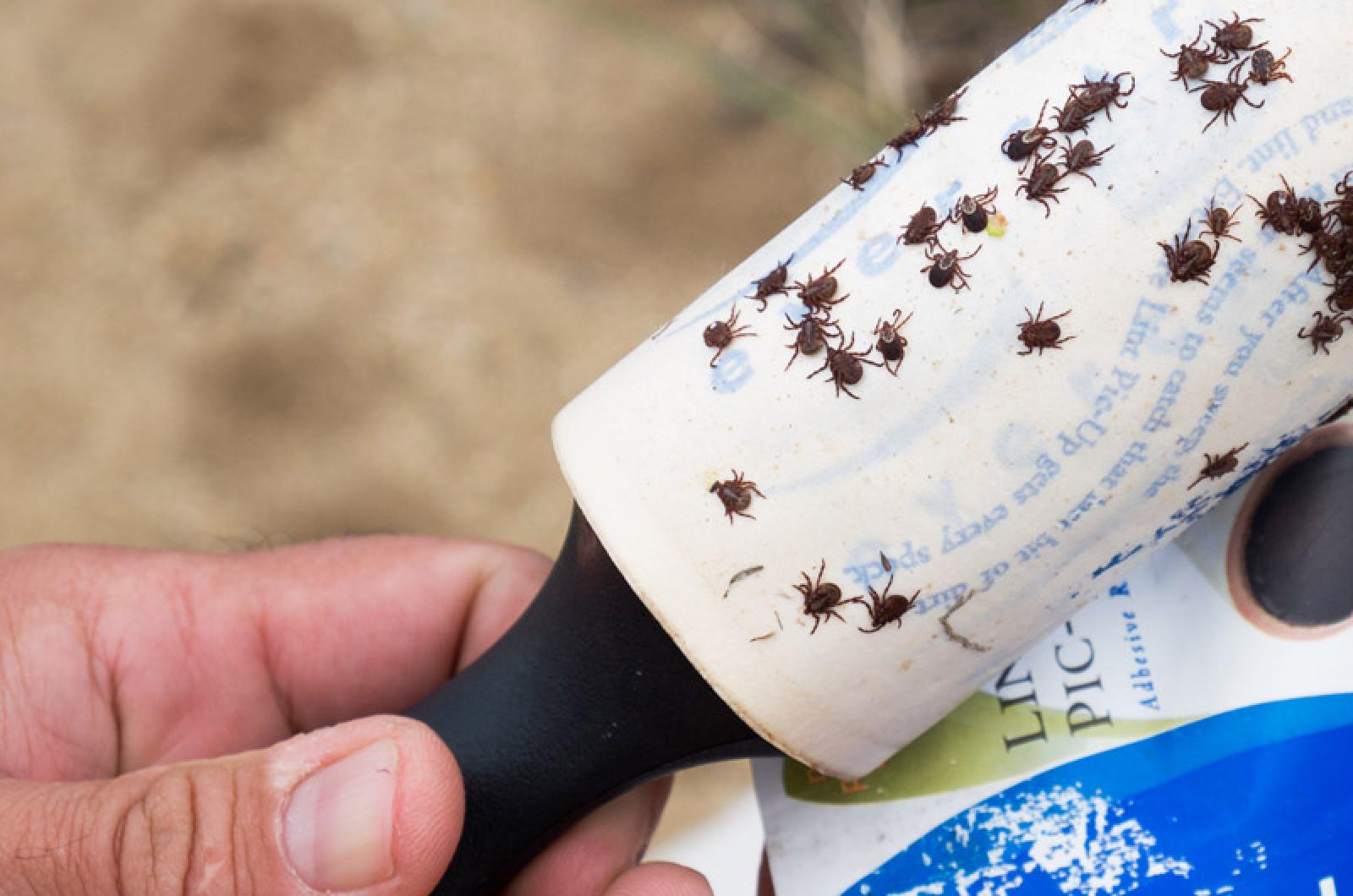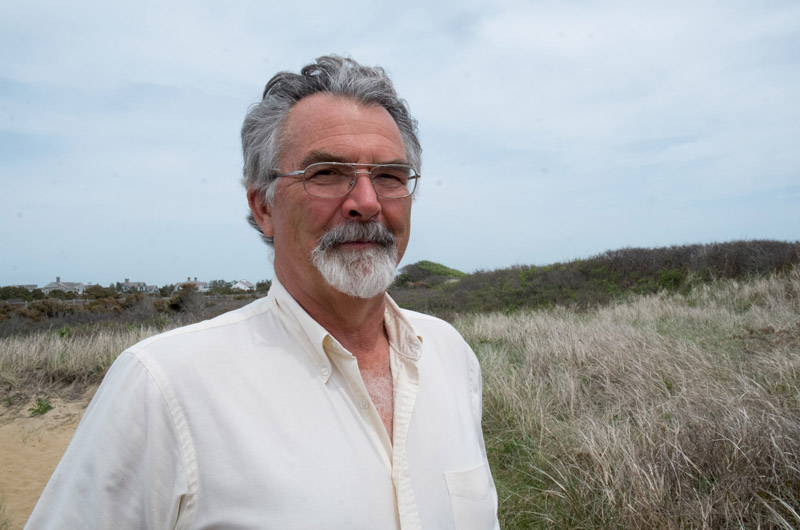Sam Telford and Dick Johnson arrived at South Beach in the early afternoon Wednesday in long-sleeved shirts and pants tucked into their socks. Mr. Telford, a professor at Tufts University and a leading tick biologist, unfurled a fuzzy white flag and casually dangled it from his side as he strolled along the sandy path to the beach.
After just two short passes, the flag was covered in ticks.
“One of these might have tularemia,” Mr. Telford said, referring to the tick-borne illness that was so severe before the days of antibiotics that the U.S. and Russian governments both stockpiled it as a biological weapon.
Mr. Telford used an adhesive lint roller to collect the ticks and continued swiping with the flag.
Mr. Telford’s research on the Island has greatly benefitted the Tick-Borne Illness Reduction Initiative, an Islandwide program that began about four years ago with a grant from the Martha’s Vineyard Hospital. Funding for the program will end this year, but Island health agents plan to continue the efforts, which include school programs, a web page, and a series of educational videos.
Michael Loberg, who co-chairs the program and is also chairman of the Tisbury board of health, noted that the grant originally entailed a commitment from the community beyond the first five years.
Last year, Mr. Loberg founded the Vineyard Center for Clinical Research in Vineyard Haven, a nonprofit that is conducting clinical studies to improve the diagnosis of tick-borne illness. He hoped that sponsorship for the studies, along with donations, would support the continued education and field work that began with the grant.
The ultimate goal of the studies is to improve disease treatment. “There is a variety of therapies that people are looking at,” Mr. Loberg said. “But it’s hard to follow their effectiveness without a better diagnostic tool.”
Prevention measures like tucked-in pants and tick repellents can be highly effective, said Edgartown health agent Matt Poole, who also co-chairs the disease reduction program. But he added that people should also learn to recognize the flu-like symptoms and telltale bull’s eye rash associated with Lyme disease and to understand early treatment, which may include doxycycline as a prophylactic.
“It’s all of those pieces together,” Mr. Poole said.
The initiative has focused largely on educating children and families, since children are most at risk. One of the most innovative efforts so far, Mr. Loberg said, was to enlist Island health experts to educate high school students, who in turn educated grade school students around the Island. One high school group used a quiz-show format to educate students in Edgartown.
“The kids loved it,” Mr. Loberg said. “It was just impressive to see how much the kids learned doing this.”
Two years ago, Island students were sent home at the end of the year with a DVD on tick-borne illness awareness and prevention, produced in both English and Portuguese. “That was an effort to get the kids to take this information home and hopefully for it to become part of family knowledge,” Mr. Poole said.
Wednesday was a cool day at South Beach, so the ticks were not out in force, but during the summer, Mr. Telford said, the flag might collect 100 ticks in just one or two steps along the dunes.
There have been perhaps 130 cases of tularemia on the Vineyard over the last 15 years, accounting for about 10 per cent of nationally reported cases. Symptoms typically include an ulcer at the site of the infection, swollen lymph glands, fever, chills, headache and exhaustion. But more common tick-borne illnesses include Lyme disease and babesiosis.
South Beach is a hot spot for dog ticks. “The only thing I can think of is there are a lot of skunks and raccoons out here,” Mr. Telford said, pointing out a small laundry basket overflowing with garbage behind a changing station.
Mr. Telford also has a long-term study site in Chilmark where ticks are abundant. Chappaquiddick is another hot spot on the Island. In general, rural areas have more ticks, especially areas with an abundance of deer, which provide food and a means of transportation. As part of his efforts to support the reduction initiative, Mr. Telford has recently shifted some of his attention back to deer ticks, which carry Lyme disease.

Mr. Telford and Mr. Johnson both are working to encourage Island communities to take stronger action to reduce the incidence and severity of tick-borne illness.
Mr. Johnson, an Island biologist, has studied ticks for years and runs a yard assessment program for residents of Chilmark and Chappaquiddick. Recommendations might include removing leaf litter and other damp environments where ticks thrive, and clearing vegetation to allow for more sunlight. So far the assessments have been free, thanks to the grant, but the recommendations are often ignored. “There is the thought that perhaps if people paid for them they might actually take them a little more seriously,” Mr. Poole said.
“There is a sort of fatalism that the ticks are here, we’ve lived with them for so many years, it’s just part of the Island,” Mr. Johnson said. He noted a similar resignation over the high price of gas on the Island.
“A lot of people have this attitude that you can’t do anything,” said Mr. Telford. “But that’s not true. You just need the motivation.”
Mr. Johnson has been treated four times for Lyme disease, experiences that he said helped him to change his lifestyle for the better. “I may look kind of silly but I don’t get bitten anymore,” he said, noting his attire for the beach outing. One problem here, he said, is that businesses tend not to carry the tick toxin permethrin. Despite people’s concerns, he said, the chemical presents a much smaller risk than Lyme disease. Reported cases of Lyme disease are likely much lower than actual cases, in part because not all patients are officially diagnosed. Mr. Loberg said that as much as 85 per cent of the prescriptions for doxycycline on the Vineyard were written to treat tick-borne illness. “Rather than the 20 to 40 cases of Lyme disease that are actually reported on the Island, the number is more like 1,500,” he said.
Continued efforts on the Island might include establishing a permanent “tick czar” to reside at the Dukes County offices. Mr. Poole noted differences in public opinion over the effectiveness of county government, but believed the Islandwide body would be the logical place for such a service.
Mr. Telford agreed, noting that the program could help shoulder the cost of public health, which is generally borne by families and individuals. “There is no reason why Martha’s Vineyard can’t initiate a pioneering program like that,” he said.
He also noted that with the poor economy, “research funding has gone down the toilet,” and stressed the importance of volunteer services. Disease prevention programs such as the yard assessments could be a community effort similar to beach clean-up, he added. “But we have yet to see people suggest that sort of thing.” In recent years, reports of a new tick on the Island have stirred some concern. Along with his work with dog ticks, Mr. Telford is an expert in the less common lone star tick, named for the white dot on the backs of females. Despite the recent concerns, he said he has been finding lone star ticks on the Vineyard since the late 1990s. “There is nothing new about this tick,” Mr. Telford said.
He said the big question is why the lone star tick is not as prevalent here as it is on Long Island, Cuttyhunk and other places where it has become a serious pest.
“The question is, will the Vineyard ever develop a pest-level problem,” Mr. Telford said. If it did, people would know about it, since the ticks are more aggressive and their bites are painful. Unlike dog and deer ticks, lone star ticks can orient toward light and dark and will move toward you.
But the numbers on the Island have been small, and samples from all three stages of the tick’s life cycle have yet to be reported, so there is no evidence that the loan star tick has become established.
“It’s the early stages of invasion,” Mr. Telford said.
As one long-term effort, Mr. Telford and others are pushing for better control of the Island deer population, since deer provide food for ticks, facilitating their life cycle changes, and spread them around the Island. Counter-intuitively, the establishment of lone star ticks might help kick start those efforts.
“There is just not enough interest around the communities here to do anything,” Mr. Telford said. “But if lone star ticks become a problem then we might start talking again.”









Comments (4)
Comments
Comment policy »